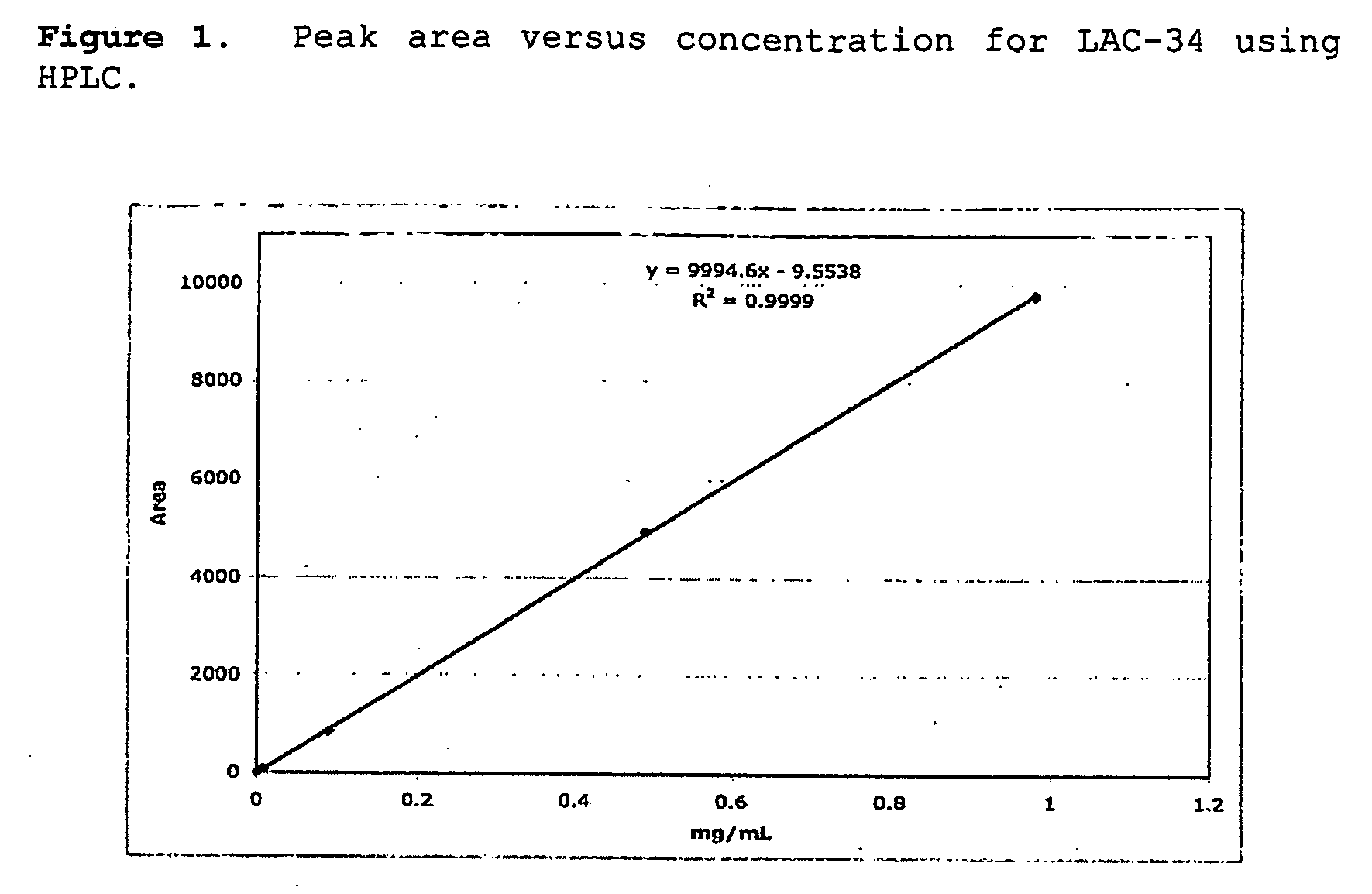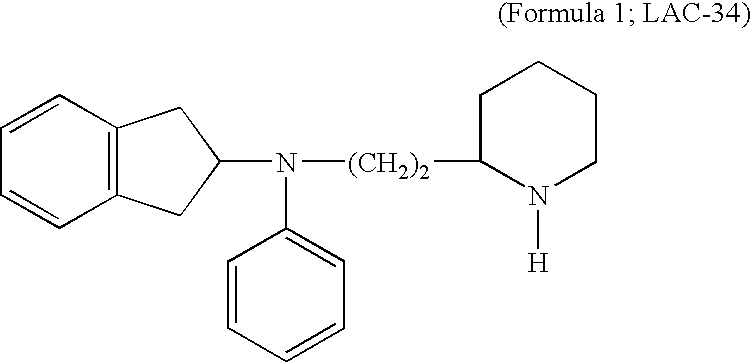Formulations of Indanylamines and the Use Thereof as Local Anesthetics and as Medication for Chronic Pain
a technology of indanylamine and local anesthetic, which is applied in the field of indanylamine formulations, can solve the problems of ineffective treatment, incomplete understanding of neuropathic pain, and ineffective standard formulations of indanylamine, and achieve the effect of improving the therapeutic activity and potentiating the local anesthetic activity
- Summary
- Abstract
- Description
- Claims
- Application Information
AI Technical Summary
Benefits of technology
Problems solved by technology
Method used
Image
Examples
example 1
Development of Analytical Method
[0054]Racemic LAC-34 as a free base (Lot # GLS-L7-163) was used for this study. All solvents were USP, NF, ACS Reagent, or HPLC (acetonitrile) grade. The free base of LAC-34 can exist as a white powder or as a yellowish-brown crystal or oil.
[0055]A liquid's capability to solubilize LAC-34 was screened by adding a known mass of LAC-34 to a known volume / mass of liquid. Saturation solubility was measured by adding an excess of drug substance and allowing the suspension to equilibrate while stirring for 2-3 days. A sample of the suspension was filtered though a 0.2 μm PTFE membrane followed by dilution (if required) and HPLC analysis. For several mixed solvent systems that included water, a known mass of drug substance was dissolved in a known mass of solvent(s). This solution was then titrated with water while stirring until the solution became cloudy. All solubility measurements were conducted at room temperature (approximately 21-23° C.).
[0056]HPLC ana...
example 2
[0060]Various excipients were tested for their capability to dissolve LAC-34, free base. Some results from these screening tests are shown in Table 2.
TABLE 2Solubility of LAC-34 free base - screeningtestsSolubility of LAC-34 (base;Excipientmg / mL)PolarEthanol>86Isopropyl alcohol>79Propylene glycol>76Benzyl alcohol>100Propylene carbonate>78Hexylene glycol>75Semi-polar / non-polarDibutyl adipate>79Isopropyl myristate>78Isopropyl palmitate50-100Mineral oil
[0061]With the exception of mineral oil, LAC-34 could be dissolved in high concentrations in all the solvents tested. LAC-34 has a yellowish-brown color when it exists as a glass and solutions in Table 2 were yellowish-brown.
[0062]When tested at 4° C., 20% LAC-34 in benzyl alcohol was still a solution, 5% LAC-34 in propylene glycol was a gel, 5% LAC-34 in isopropyl myristate was a suspension, 5% LAC-34 in isopropyl palmitate was a solid, 5% LAC-34 in isopropyl alcohol was a suspension and cetyl alcohol was a solid (melting point=49.3° C....
example 3
Tests of Saturation Solubility in Selected Solvents
[0063]The saturation solubility of LAC-34 was measured in capric / caprylic triglycerides (CCT), dimethylsulfoxide (DMSO), ethanol, isopropanol, isopropyl myristate (IPM), pentane, propylene glycol (PG), and water. CCT and IPM were selected for further work since they can function as emollients and oily vehicles in creams. DMSO is a solvent and a penetration enhancer. Ethanol and isopropanol are volatile solvents and rapid evaporation of a solvent like ethanol and isopropyl alcohol may be important for minimizing therapeutic onset time. Propylene glycol has multiple functions in dermal formulations, the most important of which are solubilization and penetration enhancement. Some results from the saturation studies with LAC-34 are shown in Table 3.
TABLE 3Saturation solubility of LAC-34 free base inkey solvents for dermal drug delivery.LAC-34 Solubility,Solventsmg / mLCapric / caprylic195triglycerides (CCT)215DMSO>2,000Ethanol>526, Isopropa...
PUM
| Property | Measurement | Unit |
|---|---|---|
| Fraction | aaaaa | aaaaa |
| Fraction | aaaaa | aaaaa |
| Fraction | aaaaa | aaaaa |
Abstract
Description
Claims
Application Information
 Login to View More
Login to View More - R&D
- Intellectual Property
- Life Sciences
- Materials
- Tech Scout
- Unparalleled Data Quality
- Higher Quality Content
- 60% Fewer Hallucinations
Browse by: Latest US Patents, China's latest patents, Technical Efficacy Thesaurus, Application Domain, Technology Topic, Popular Technical Reports.
© 2025 PatSnap. All rights reserved.Legal|Privacy policy|Modern Slavery Act Transparency Statement|Sitemap|About US| Contact US: help@patsnap.com


